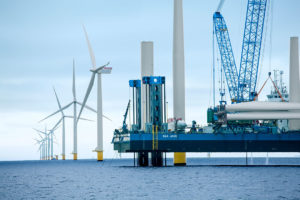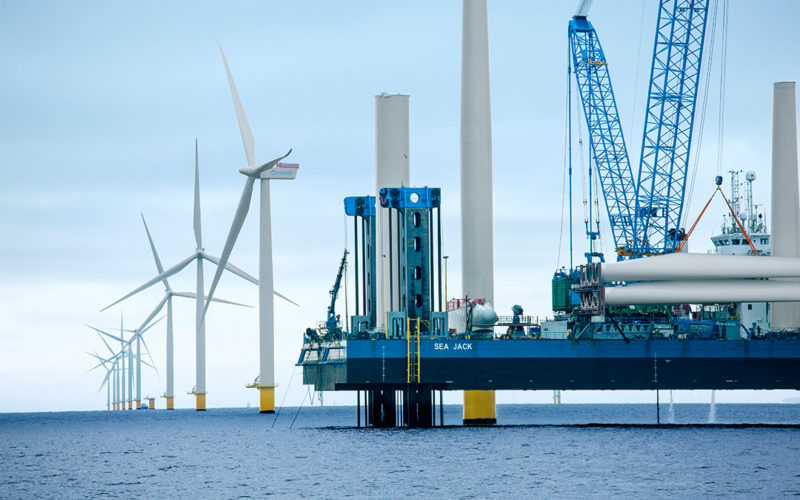
The Dutch-built wind turbine installation vessel Aeolus carries a top-range crane that can lift 1,600 tons. It can work in 135 feet of water thanks to 279-foot legs, each weighing 1,280 tons.
These capabilities are necessary to handle next-generation offshore wind turbine towers measuring over 850 feet and weighing 500 tons. Installing one on the ocean floor requires a vessel with retractable legs allowing the ship to transition from boat to offshore platform.
Aeolus is a rare kind of ship. In November 2020, the research firm Rystad Energy counted 32 active turbine installation vessels (WTIVs) in the world. None are U.S.-flagged.
This lack of U.S.-flagged WTIVs could hinder growth in America’s offshore wind industry. The Biden Administration wants 2,000 turbines up and running by 2030, and it has eased regulatory and permitting processes to help reach that goal. With a wind farm near Martha’s Vineyard already approved, and the administration looking to lease other areas, the U.S. has no WTIVs or other large wind farm support vessels that meet Jones Act requirements.
To put it simply, the industry wants to put down turbines soon, but for now it has none of the specialized and very expensive ships to do it.
Still, industry groups are not panicking yet, for several reasons.
First, there is much work to be done before turbines can be installed. With few exceptions, most offshore wind farm projects are still in the earliest stages. Leaseholders must survey the sites and assemble the turbines, meaning installation might not begin for years. The few ports capable of handling a wind turbine installation operation must be expanded or upgraded.
“In 2023, they might be going into the water,” predicts Ross Gould, vice president for supply chain development for the Business Network for Offshore Wind. Also, the industry needs only a few ships, open to leasing, for the number of windfarms feasible for the East Coast in this decade. “We are talking about three to four ships,” he said.
It’s a manageable goal, and several companies have announced plans to build WTIVs in the U.S., at a cost of $200 to $500 million per ship. Investing in a highly specialized ship of this kind was a prohibitively expensive investment, Gould said, until the federal government, which regulates construction in the seas, showed a commitment to wind power.
Dominion Energy, a power utility based in Richmond, Va., announced plans in December to build its own WTIV. That vessel will service Coastal Virginia Offshore Wind, the utility’s large scale wind farm planned for 27 miles off Virginia Beach. Eneti, a Monaco-based company specializing in offshore wind construction, is looking for American partners to build U.S.-flagged installation vessels, its CEO said in a conference call. Lastly, Lloyd’s Register North America and Northeast Technical Services Co. are exploring whether existing vessels can be modified into WTIVs.
If Jones Act-compliant vessels are not available, companies have a work-around: The law does not regulate construction. A turbine could be delivered from a foreign port by a foreign-flagged vessel, which then installs it in U.S. waters. Builders of American windfarms could then use “feeder” ships to deliver everything necessary for construction. Never would a non-U.S.-flagged vessel deliver anything from one U.S. port to another, thus bypassing Jones Act rules.
Out of necessity, builders of early offshore wind power projects utilized this loophole. To create the Block Island Wind Farm, the nation’s first, parts were constructed in France and delivered to the project site off Rhode Island by a Dutch-owned ship that installed the turbines.
Vineyard Wind, a 62-turbine project approved in May, will go this route. Its builders will contract with the U.S. branch of Belgian wind developer DEME to bring in the turbines, and the vessels to install them, from the company’s operations in Belgium. U.S.-flagged ships will be used for the rest of the operation, a spokesperson said.
Dominion Energy did something similar for its two-turbine pilot program off Virginia Beach. The turbines were constructed in Nova Scotia and transported on a Luxembourg-flagged WTIV.
The process convinced Dominion to build its own vessel. The company concluded it was not feasible to install dozens of turbines that way, waiting on foreign ships, foreign ports and foreign builders. Dominion, which plans to spend $500 million on the ship, found the benefits of building their own WTIV outweighed the costs.
The adage that time is money is especially true at sea, said Claire Richer, director of federal affairs for the American Clean Power Association. Labor, logistics and fuel costs add up fast. “Companies have every incentive to minimize the time at sea,” she said.
While WTIVs have an indispensable role, a wind turbine installation requires an entire fleet: Vessels that service turbines, move people and supplies, and house crew and workers, Richer said. An entirely U.S.-based wind turbine installation infrastructure, with U.S.-flagged WTIVs, would limit the amount of time these other ships and their crews are transiting to and from the job site, and the amount of time working at a specific installation.
All told, more than a dozen different vessels can be used in an offshore wind turbine project from start to finish. These include everything from highly specialized WTIVs, service operations vessels (SOVs) and crew transfer vessels (CTVs) to more traditional vessels already within the U.S.-flagged fleet such as tugboats and barges, survey vessels, supply vessels and heavy-lift ships.
According to Matthew Tremblay, senior vice president of global offshore markets for the American Bureau of Shipping, there is one silver lining to the under-developed state of the American offshore wind market: Developers in Europe and Asia have already mastered the process.
“Coming from Europe, I think the installation process itself has been developed and is clearly understood and the ins and outs of doing these installations offshore are no longer a question,” Tremblay said. “The developers have come to understand that clearly, and they got that process down.” •

